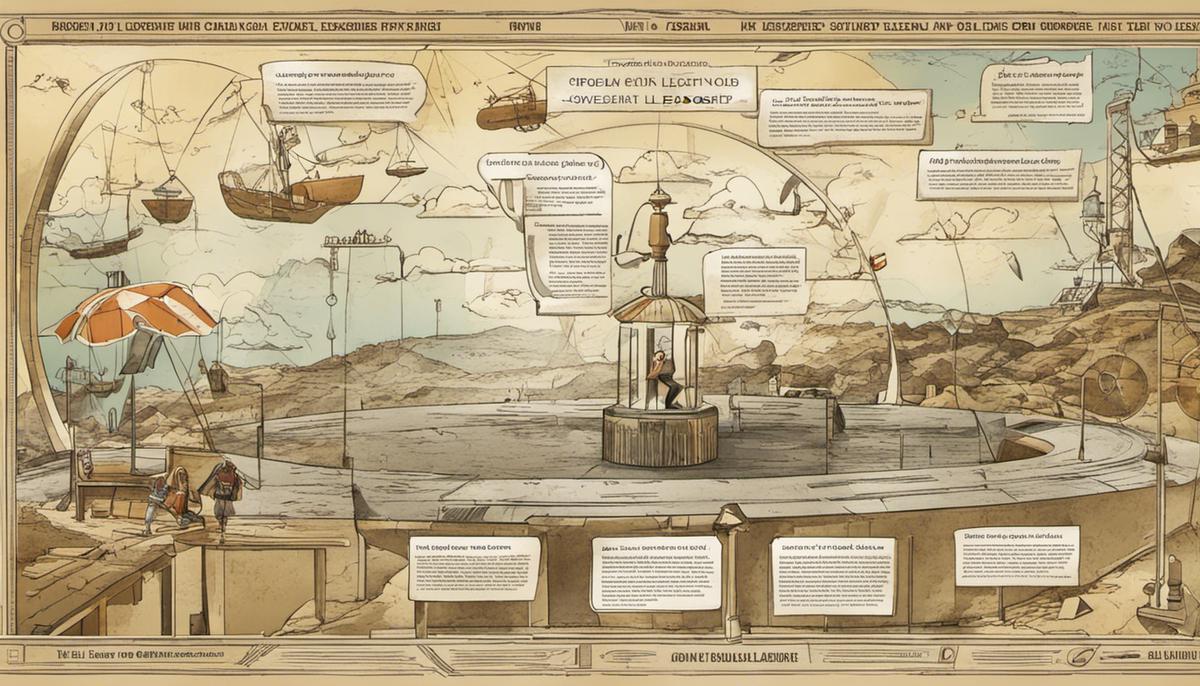Identifying the precise role effective leadership plays in addressing and solving complex issues is an essential aspect in the professional realm. An important aspect, which often gets overlooked, is problem-solving leadership, a skill that centers around navigating challenging circumstances, implementing strategic solutions, and influencing team members in the process. This profound leadership style enables professionals to maneuver proficiently through intricate organizational scenarios. The purpose of this essay is to unpack the fundamental concepts regarding problem-solving leadership, explore the prime principles behind it, delve into useful tips to develop this coveted skill, and demonstrate its real-world application in various workplace settings.
Understanding Problem Solving Leadership
Understanding Problem Solving Leadership
Problem-solving leadership refers to a leadership style that emphasizes finding solutions to challenges within the organization. Different from other leadership styles, problem-solving leadership operates on the basis of diagnosing issues, generating potential solutions, and then implementing the most effective one. Such leaders are often highly adaptable and proactive, supporting their team through hurdles and fostering a climate of creativity and innovation to overcome complex organizational problems.
Significance of Problem-Solving Leadership
In the ever-changing landscape of the business world, leaders who can adeptly navigate challenges are paramount. Organizations can greatly benefit from problem-solving leadership as it curbs stagnation and catalyzes progress. When leaders are skilled at comprehending problems, developing strategic solutions, and effectively putting those into practice, it leads to improved productivity, morale, and financial performance. Moreover, a problem-solving leadership style fosters resilience, enabling organizations to withstand adversity and thrive in challenging circumstances.
Characteristics of a Problem-Solving Leader
Leaders who excel in problem-solving usually exhibit a range of specific characteristics. They are typically analytical and are able to dissect complex problems into manageable components. Additionally, they are resilient and optimistic, maintaining a positive mindset despite obstacles. Their cognitive flexibility allows them to adapt their perspective and approach when necessary. Through their innovation, they generate novel and effective solutions, while their decisiveness ensures these solutions are implemented promptly and effectively. They also encourage a culture of open communication, making sure that everyone’s opinions and ideas are heard and considered.
Roles of a Problem-Solving Leader in an Organization
Problem-solving leaders play numerous pivotal roles in organizations. To start with, they often act as catalysts for change, steering their organizations toward continuous improvement. They initiate and facilitate discussions to understand problems from various perspectives and collaborate to craft fitting solutions. They organize resources and strategize to implement solutions without disrupting the overall workflow. More so, effective problem-solving leaders develop the problem-solving abilities of their team members, promoting a culture of learning and development.
Problem Solving Leadership Skills
Crucial skills for problem-solving leadership include critical-thinking, decision-making, and communication. Critical-thinking refers to the ability to identify problems, dissect them into smaller parts, analyze each part, and evaluate possible solutions. Decision-making is the ability to choose the most suitable solution from several alternatives, while communication involves expressing ideas clearly and persuasively, as well as listening to others. These skills are not inherent but can be learned and developed with consistent practice and application.
In every organization, problem-solving leadership stands as a crucial asset. This ability calls for more than just command over one’s duties – it necessitates having the right mindset, adequate skills, and a robust toolkit for navigating through uncertainties and turning issues into promising opportunities.

Principles of Problem Solving Leadership
Core Values Underpinning Problem-solving Leadership
An effective leader who excels in problem-solving leans on several key values, including group-centric decision-making, nurturing creativity and innovation, handling crisis situations, and embracing complete responsibility. These aren’t standalone principles but rather interconnected elements that bolster one another. Together, these create a leadership style that paves the path for successful problem resolution and team triumphs.
Collaborative Decision Making in Problem-Solving Leadership
A cornerstone of problem-solving leadership is the consolidation of the strengths and insights of all team members in the decision-making process. It encourages togetherness and shared responsibility, factors that are crucial for team cohesion and productivity. Through collaborative decision making, team members are empowered to do their part in problem-solving, which can lead to faster and more effective solutions.
Promoting Creativity and Innovation in Leadership
Problem-solving leadership also relies on fostering an environment conducive to creativity and innovation. Leaders should actively promote and recognize creative ideas, inspiring team members to think outside the box to solve problems. This approach leads to a variety of solutions, improved problem-solving capabilities, and, consequently, enhanced competitiveness in an ever-evolving business landscape.
Crisis Management: A Key Aspect of Problem-Solving Leadership
Another integral principle of problem-solving leadership is effective crisis management. Leaders should possess the ability to remain calm under pressure, act decisively and efficiently, and guide their teams through periods of uncertainty. By anticipating potential crises and preparing for them, leaders can cushion their team and organization against the effects of unforeseen challenges and bounce back with minimal operational disruption.
Taking Responsibility in Problem-Solving Leadership
Leaders must also be willing to take responsibility in solving problems. They should demonstrate accountability for the decisions made and any potential consequences. This principle fosters trust and respect from team members, making it easier to navigate the problem-solving process collectively.
Unveiling the Power of Effective Problem-Solving Leadership
There is a profound interconnection between proficient problem-solving skills and high-impact leadership. A leadership style characterized by its emphasis on collaborative decision-making, creativity, and innovation not only enables effective crisis management and accountability but also fosters a problem-solving culture within the team. It is this very culture that inspires proactive, efficient, and optimized responses to challenges, thereby accelerating the team’s journey towards meeting organizational goals.

Techniques for Developing Problem Solving Leadership Skills
Navigating the Complexities of Problem-Solving Leadership Skills
Problem-solving leadership skills play a pivotal role in steering professionals through any hurdles encountered within their organizations or businesses. Such expertise goes beyond merely active listening, critical thinking, adaptability, conflict resolution, and robust communication. It extends to a deeper comprehension of strategic decision-making, team unification, and forward planning. The honing of these skills allows leaders to convert problems into platforms for growth and development-
Active Listening and Problem Solving Leadership
Active listening plays a key role in problem-solving leadership, as leaders must fully grasp the nature of the problem at hand before trying to tackle it. This involves truly hearing and understanding what other team members are communicating, not just on a surface level but also discerning underlying concerns or ideas. Active listening can reveal facets of a situation that are not readily apparent, making it a valuable tool for informed problem solving.
The Role of Critical Thinking
Critical thinking is another crucial component of problem-solving leadership. It involves analyzing problems objectively, separating facts from assumptions, and evaluating different alternatives to determine the best course of action. A critical thinker should be able to foresee potential outcomes of various decisions, considering both short and long-term effects. With critical thinking, leaders can make informed decisions that serve the best interests of the team or organization.
Importance of Adaptability in Problem Solving
Problems and challenges are often unpredictable, and successful leaders must be adaptable to handle shifting circumstances. Being flexible allows leaders to change their strategy or approach as needed without getting stuck in rigid thinking patterns. Adaptability can turn unexpected obstacles into opportunities, allowing for creative and innovative problem-solving solutions.
Conflict Resolution as a Problem-Solving Tool
Conflict resolution is an integral part of problem-solving and leadership. When conflict arises, leaders should step in to mediate, fostering open communication, collaboration, and mutual respect among the team members. Effective conflict resolution can prevent minor issues from escalating into significant problems, while also encouraging a constructive, solution-focused culture within the team.
Effective Communication and Problem Solving
Clear, concise communication is vital in problem-solving leadership. A leader needs to articulate the problem, proposed solutions, and chosen plan of action in an understandable way. Regular, open communication can keep everyone aligned, encourage feedback, and reduce misunderstandings. Furthermore, it can aid in creating a positive team environment where everyone’s input is valued.
Personal Self-Assessment in Improving Leadership Skills
Self-assessment is a valuable process in developing problem-solving leadership skills. By reflecting on their strengths and weaknesses, leaders can identify areas for improvement and plan the steps to becoming more effective in their leadership role.
Professional Development Tools for Enhancing Leadership Skills
Professional development tools, including workshops, training courses, and coaching, can significantly enhance problem-solving leadership skills. These training opportunities are designed to broaden leadership capabilities and promote practical learning through case studies, interactive scenarios, and hands-on experiences. They can help a leader develop a fresh perspective, gain new problem-solving techniques, and improve decision-making skills.
The Role of Continuous Learning in Problem-Solving Leadership
Developing problem-solving leadership skills is not a one-time event but a lifelong commitment to improvement. Staying current with emerging theories and strategies and applying them to your work scenario is key. Utilize the feedback from team members to understand your strengths and opportunities, helping to fine-tune your leadership style. Above all, embracing a culture of perpetual learning is crucial for your evolution as an efficient problem-solving leader.

Applying Problem Solving Leadership in the Workplace
Delving Into Problem Solving Leadership
The essence of problem-solving leadership touches every spectrum of team or organization management. This leadership style is primarily centered around recognizing, evaluating, and successfully tackling challenges that could obstruct a team’s progress or organizational productivity. A problem-solving leader employs sharp critical thinking skills, strategic analysis, and optimal resource use to devise effective solutions. They also cultivate an atmosphere that encourages team members to suggest innovative solutions and provide constructive criticism, ultimately promoting shared creativity and accountability.
Examples of Problem-Solving Leadership in the Workplace
A prime example of problem-solving leadership is when a leader encounters workplace conflict between two team members. Rather than ignoring or dismissing this issue, a proficient problem-solving leader addresses the conflict head-on. They may hold a meeting with the individuals involved to understand each party’s perspective and help them find an amicable resolution.
In project management, problem-solving leadership is crucial. Delays, unforeseen technical difficulties, or resource shortages can disrupt project progress. Effective problem-solving leaders analyze the issue and devise viable strategies to steer the project back on track, such as adjusting timelines, reallocating resources, or seeking additional technical support.
Another example would involve a company facing a decline in sales. A problem-solving leader would take the initiative to identify any underlying issues contributing to this decline and develop a sound strategy to address these, such as reworking marketing strategies, refining customer outreach, or adjusting product pricing.
Case Studies Showcasing Successful Problem-Solving Leadership
Many organizations have been able to overcome complex issues using problem-solving leadership. One such case is Starbucks’ reaction to declining sales in 2008. CEO Howard Schultz reappraised the situation, identified the problem of brand dilution due to rapid expansion, and took action by altering the growth strategy, closing underperforming stores, and investing in staff training to improve customer service. This problem-solving approach led to a significant turnaround in sales and customer satisfaction.
Another excellent example of problem-solving leadership is presented by Netflix. When they faced a major backlash in 2011 after an unpopular separation of DVD rental and streaming services that led to significant customer loss, their CEO, Reed Hastings, acknowledged the company’s error. He reviewed the situation, revised the strategy, and ultimately guided the company to become one of the most successful streaming services today.
Emphasizing Problem-Solving Leadership in the Workplace
For significant improvements in an organization’s general functionality, problem-solving leadership should be prioritized. Leaders must promote active problem identification and solution seeking not only within themselves but across their teams. By implementing regular problem-solving meetings and fostering an open, communicative environment, leaders can proactively address issues and devise effective solutions together. Recognizing and rewarding team members for their successful problem-solving efforts can also foster a culture of continuous improvement and help build stronger, more effective teams.

This deep dive into problem-solving leadership illuminates the effectiveness of this leadership style in dealing with intricate organizational difficulties. The principles of collaboration, creativity, responsibility, and crisis management form the bedrock of this effective leadership approach. It’s clear that honing one’s skills in critical thinking, effective communication, active listening, and conflict resolution can greatly enhance one’s capacity as a problem-solving leader. Indeed, the real-word examples and case studies that were discussed serve as a testament to the transformative power of problem-solving leadership in today’s dynamic work environment. It only underscores the immense value and potential returns from fully embodying and applying this leadership style in one’s professional journey.
